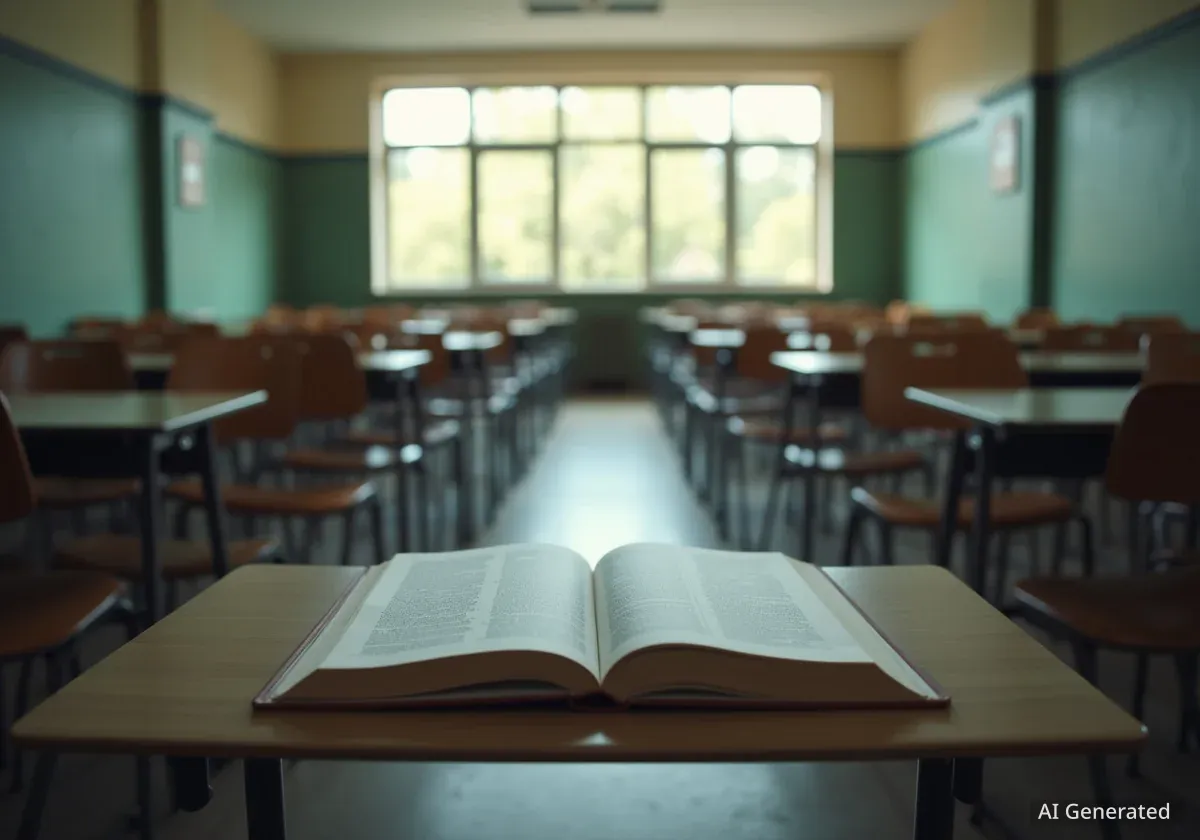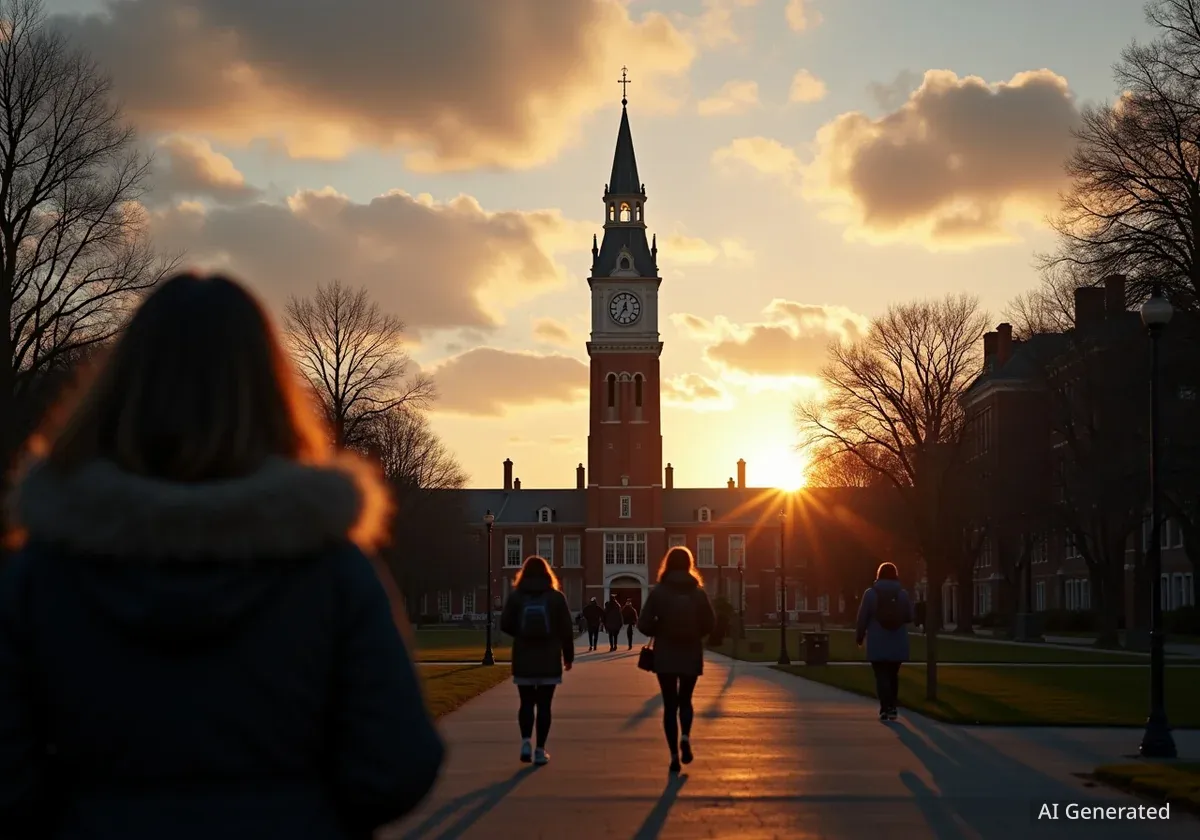Alabama's public school system is experiencing its most significant enrollment decrease in four decades, with a loss of approximately 5,700 students this year. This decline is projected to lead to the elimination of 500 to 700 teacher positions in the upcoming budget cycle, according to State Superintendent Eric Mackey.
The substantial reduction in student numbers has raised concerns among education officials regarding both funding and the welfare of thousands of students who are currently unaccounted for.
Key Takeaways
- Alabama public schools lost about 5,700 students this year.
- This is the largest enrollment decline in 40 years.
- Between 500 and 700 teacher jobs are expected to be cut.
- Approximately 3,000 students transitioned to private or home schooling via the CHOOSE Act.
- About 2,100 students are currently unaccounted for by school officials.
Significant Drop Impacts School Funding
State Superintendent Eric Mackey presented these preliminary figures to the Alabama State Board of Education on Thursday. He noted that while the numbers are not yet final, the overall reduction is expected to settle around 5,000 students. This represents a critical shift for the state's education system.
The decrease in student enrollment directly affects the allocation of state funds for public schools. Funding for teaching positions is tied to student counts, meaning fewer students translate to fewer resources for staff.
"This will be the largest reduction we've had in the last four decades," Mackey stated, underscoring the severity of the situation. "Teacher jobs are tied to student enrollment. This is between 500 to 700 teacher jobs that will disappear next year as we work on the next budget cycle. So it's a big impact."
This projected loss of teaching staff could place additional strain on remaining educators and potentially impact class sizes across the state.
Enrollment Snapshot
- Total Student Loss: Approximately 5,700
- Students Using CHOOSE Act: Around 3,000
- Unaccounted Students: Approximately 2,100
- Projected Teacher Job Cuts: 500-700
Understanding the Student Exodus
Mackey explained that the student losses stem from two primary factors. The first is the implementation of the CHOOSE Act, a state initiative allowing families to use education savings accounts for private or home schooling. Approximately 3,000 students are estimated to have left public schools through this program.
"That was not unexpected," Mackey said, noting that this trend had been previously reported. The CHOOSE Act aims to provide parents with more educational choices, but it has a clear impact on public school enrollment figures.
The second, and more concerning, factor involves a group of students whose whereabouts are unknown. An estimated 2,100 students who were enrolled last year simply did not return to public schools this academic year and have not been accounted for elsewhere.
The CHOOSE Act
The CHOOSE Act, or Creating Hope and Opportunity for Our Students' Education Act, is an Alabama law that provides education savings accounts (ESAs) to eligible families. These accounts can be used to cover various educational expenses, including private school tuition, homeschooling costs, and other approved services. The program aims to offer alternative educational pathways for students.
The Mystery of Missing Students
The 2,100 unaccounted-for students represent a significant challenge for state education officials. These students did not transfer to private schools, were not reported as homeschooled, and did not enroll in schools in other states. They effectively "just disappeared" from the public education system.
"We have essentially 2,100 kids that were enrolled last year that just didn't show up," Mackey elaborated. "They didn't transfer to a private school, they didn't go to homeschool, they didn't go to school in another state. They just disappeared."
District superintendents statewide have reported to Mackey that a majority of these missing students are Hispanic. However, schools are prohibited from verifying a student's immigration status under federal law, complicating efforts to track their movements.
Challenges in Tracking Students
Mackey outlined the various possibilities for the missing students. "We don't know if they're still living in this state and just not going to school, if they have moved to another state and did not enroll there, or if they left the country," he explained. "We don't know if they were documented or undocumented, because under federal law we are not allowed to ask, and we don't ask."
This lack of verifiable information makes it difficult for authorities to ensure these children are receiving an education, regardless of their location or status.
Local Impact and State Response
Albertville City Schools, a district with a large Hispanic student population (60%), reported an overall enrollment decline of approximately 190 students this year. Superintendent Bart Reeves noted that while Hispanic students account for some of this drop, other factors are also at play.
Reeves stated that a portion of the decrease is due to the district's stricter enforcement of policies for students living outside the district's boundaries. In the 2024-25 academic year, Albertville enrolled 3,505 Hispanic students. This year, that number is 3,416, a decline of 89 students.
According to Reeves, most Hispanic students who withdrew were "in good standing but relocated to either other states, nearby districts or their countries of origin." He added, "While we have seen some movement among families, overall enrollment patterns and district demographics remain largely consistent."
Urgency for Re-enrollment
Superintendent Mackey expressed particular concern that some families might be keeping children out of school temporarily. He emphasized the importance of students returning to school as soon as possible to avoid significant learning gaps.
"If those students all come back to us in January and they missed a semester of instruction, we're going to teach them," Mackey said. "But the sooner they get back in school, the quicker we can catch them up and move them forward." He issued a public appeal: "If those young people are living in this state and just not going to school, I would implore publicly parents to get them back in school."
District-Level Changes
- Albertville City Schools: Overall decline of ~190 students.
- Hispanic Student Decline in Albertville: 89 students.
- Reason for Albertville Decline: Relocation, stricter out-of-district enforcement.
Final Data and Future Outlook
School districts have until next Friday to correct any data errors before the official district-level enrollment numbers are made public. However, Mackey does not anticipate any major changes that would significantly alter the overall count.
Only about a dozen districts across Alabama saw an increase in enrollment this year. "Pretty much everybody else has lost students across the board, and some have lost significant numbers of students," Mackey confirmed.
Despite the enrollment decline and the projected loss of teaching positions, Governor Kay Ivey's office reaffirmed the state's commitment to student achievement. Governor Ivey serves as the president of the board of education.
Gina Maiola, Communications Director for Governor Ivey, stated, "Gov. Ivey maintains her goal of ensuring every student in Alabama has the opportunity to receive a quality education. That includes having the best teachers in our classrooms. The continuous increase in our students' test scores prove what we are doing is working."
The state's education system faces the dual challenge of adapting to reduced funding while ensuring all children in Alabama receive an education, particularly those who have left the public school system without a clear destination.





